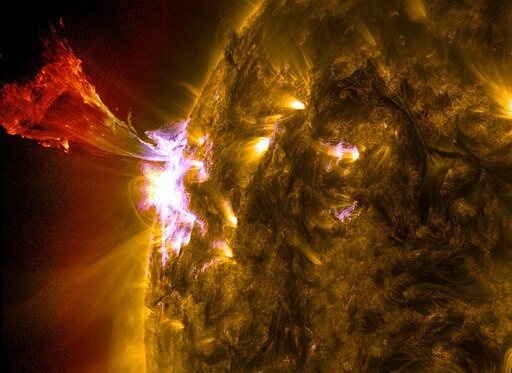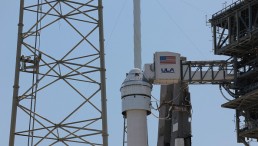For the past few days, the Sun has been active, thanks to the Sunspot AR3654. According to the latest observations from the National Oceanic and Atmospheric Administration (NOAA), this sunspot has released the most powerful eruption yet.

(Photo : Wikimedia Commons/ NASA)
Powerful Sun Blast
On April 30, the sun unleashed an extremely powerful solar flare which lasted about 12 minutes. It peaked at 7:46 p.m. EDT and ended at 7:58 p.m. EDT.
Solar flares refer to the eruptions from the surface of the Sun which release intense bursts of electromagnetic radiation. They are formed when magnetic energy accumulates in the solar atmosphere and are released.
Scientists categorize solar flares by size into lettered groups. The most powerful of them is the X-class, followed by M-class solar flares which are 10 times less powerful. The C-class flares are 10 times weaker than M-class, while B-class solar flares are 10 times less powerful than C-class. Finally, the A-class flares are 10 times weaker than B-class and almost have no noticeable effects on Earth.
Within each class, the relative strength of the solar flares are described using numbers from 1-10. According to the data from NASA's GOES-16 satellite, the April 30 solar flare was recorded at M9.53, making it almost an X-class flare.
Solar activity increases as we approach solar maximum, or the peak of solar activity during the Sun's 11-year solar cycle. Our star has almost been relatively quiet in recent weeks despite the large number of sunspots currently visible on its surface. But this is not the case anymore after the recent solar flare erupted from the sunspot region AR3654.
READ ALSO: Sun Releases 4 Solar Flares in Rare Super Explosion
Noticeable Signal Loss
The emission was so powerful that it led to a deep shortwave radio blackout across the Pacific region. When the solar flare erupted, the radiation impacted the sunlit portion of the Earth, which in this case was the Pacific ocean. After the solar flare's peak, mariners and ham radio operators may have noticed a signal loss below 20 MHz for almost half an hour.
Shortwave radio blackouts like the one witnessed over the Pacific on April 30 was not uncommon. They typically happen right after powerful solar flare eruptions brought by the emission of strong pulses of X-rays and extreme UV radiation. According to astrophysicist Ryan French, despite high numbers of sunspots during the past weeks, the near X-class solar flare on April 30 was the first decent-sized eruption in some time.
As the radiation makes its way toward Earth at the speed of light, it ionizes the top of Earth's atmosphere upon reaching us. This ionization process leads to a higher-density environment which must be navigated by high-frequency shortwave radio signals to support long-distance communication.
Powerful solar flares can significantly affect satellites, spacecraft, and ground-based technologies. For this reason, agencies such as NOAA, NASA, and the U.S. Air Force Weather Agency (AFWA) monitor the Sun closely. These organizations can give warnings to technology and infrastructure sectors which are vulnerable to solar flare activity to allow them to take appropriate measures in the event of dangerous space weather.
RELATED ARTICLE: Sun Unleashes 3 X-class Solar Flare Resulting in Back-to-Back Radio Blackouts, the Strongest in 7 Years
Check out more news and information on Solar Flare in Science Times.










![Mars Faces Three Times More Potentially Hazardous Asteroids Than Earth [Study]](https://1721181113.rsc.cdn77.org/data/thumbs/full/53711/258/146/50/40/mars-faces-three-times-more-potentially-hazardous-asteroids-than-earth-study.jpeg)



